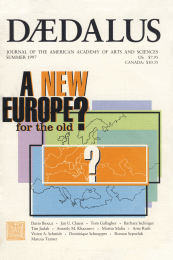“Im Osten viel Neues”: Plenty of News from the Eastern Länder
By twisting the well-known title of Erich Maria Remarque’s 1929 novel Im Westen nichts Neues (All Quiet on the Western Front), we dare to point at some refreshing and encouraging trends in the academic and social environment of higher education in the new Länder (states) of Germany.
It is remarkable, as well as indicative of new Eastern impulses, that one of the first critical articles on the German academic scene published in an internationally renowned journal was written by Hans Joachim Meyer, minister for science and art in Saxony. In March 1994, the journal Nature featured his essay entitled “Shake up for German Universities.” The subtitle of the essay made its message quite clear: “The right to a university education in any subject is enshrined in German law. But the system has become hopelessly cumbersome and is ripe for radical reform.”1
Not unlike Philipp Melanchton’s famous inaugural speech at Wittenberg (an East German university) in 1518 entitled “De corrigendis adolescentiae studiis” (“On Reforming the Studies of Youth”),2 Meyer’s appeal is directed toward reclaiming high standards in education and introducing necessary reforms. Since German unification, the five East German Länder (Brandenburg, Mecklenburg-Western Pomerania, Saxony, Saxony-Anhalt, and Thuringia) have undergone the painful task of restructuring their higher education system. A sensitive “de-indoctrination” process was necessary, in particular in the teaching of the humanities, social sciences, law, and economics at institutions in the former German Democratic Republic (GDR). The qualifications and personal suitability of individual academic faculty members were examined, and ideologically warped disciplines were “rebuilt from scratch.”3 Furthermore, two different academic systems were integrated into a federal system that had existed in West Germany for forty years. Following the evaluation by the Science Council (Wissenschaftsrat), a semi-autonomous body of scholars and administrators whose recommendations determine the all-important federal subsidy of 50 percent of all capital expenditures to institutions of higher education, five institutions were closed by the end of 1990, other institutions were integrated into larger universities—for example, many of the former teacher-training colleges— and, last but not least, by 1995 the institutions of higher education in East Germany had lost more than one-third of the staff they had in 1991. 4
. . .
Endnotes
- 1Hans Joachim Meyer, “Shake-up for German Universities,” Nature 368 (March 1994): 11-12.
- 2Richard Nürnberger, ed., Melanchtons Werke, III. Band., Humanistische Schriften (Gütersloh: Gütersloher Verlagshaus Gerd Mohn, 1961), 29-42.
- 3Rainer Künzel, “University in Transition—Part I: Investment, Structure, and Perspective; Development, Problems, and Reform Issues of the German System of Higher Education,” extended version of a paper presented at the German-American Conference on “University Transition” at the University of California, Berkeley, 16-20 March 1997, 5.
- 4Grund und Strukturdaten 1996/97, Bundesministerium für Bildung, Wissenschaft, Forschung und Technologie, published by the Bundesministerium für Bildung, Wissenschaft, Forschung und Technologie, December 1996, 236.
